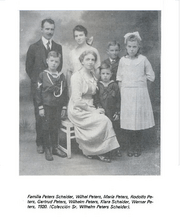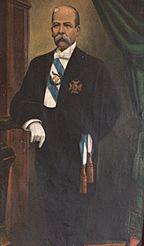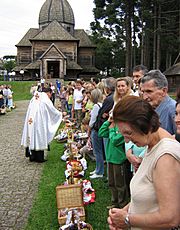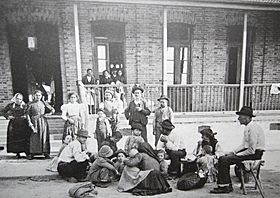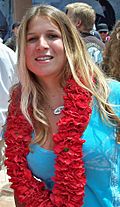White Latin American facts for kids
| Total population | |
|---|---|
| 178.6 million – 219.4 million 31.8 – 39.0% of Latin American population
|
|
| Regions with significant populations | |
| 91M | |
| 38M | |
| 18M | |
| 13M | |
| 11M-56M (est.) | |
| 10M (est.) | |
| 7.16M | |
| 5.9M | |
| 3.5M | |
| 3.3M | |
| 2.7M | |
| 2.6M | |
| 1.6M | |
| 1.3M | |
| 1M | |
| 0.950M | |
| 0.950M | |
| 0.812M | |
| 0.366 | |
| 0.089M | |
| Languages | |
| Major languages Spanish and Portuguese Minor languages Italian, French, English, German, Dutch, and other languages |
|
| Religion | |
| Predominantly Christian (mainly Roman Catholics, with a minority of Protestants), Judaism | |
|
aWhites and mulattos |
|
White Latin Americans are people in Latin America who are considered white. This usually means they have ancestors from Europe or, in some cases, the Middle East. Many people in Latin America have a mix of different backgrounds. Even a small amount of European family history could help people move up in society.
People whose families came from Europe settled in the Americas during the time of colonies and after countries became independent. You can find their descendants all over Latin America. The first settlers were mostly from Spain and Portugal. Later, many more immigrants arrived from Spain and Italy. Other groups included Germans, Arabs, Poles, Irish, British, French, Russians, Belgians, Dutch, Scandinavians, Ukrainians, Hungarians, Croats, Swiss, Greeks, and other Europeans.
White Latin Americans make up the largest ethnic group in the region. They are about 33% to 36% of the population. However, just because someone identifies as white doesn't always mean they look exactly like people from Europe. The idea of "white" in Latin America can be different from other places.
Contents
- Understanding "Being White" in Latin America
- A Brief History of White Latin Americans
- Mixing of Ancestries
- Genetic Studies of European Ancestry
- Where White Latin Americans Live
- White Populations in North America
- White Populations in the Caribbean
- White Populations in Central America
- White Populations in South America
- Argentina's White Population
- Bolivia's White Population
- Brazil's White Population
- Chile's White Population
- Colombia's White Population
- Ecuador's White Population
- French Guiana's White Population
- Paraguay's White Population
- Peru's White Population
- Uruguay's White Population
- Venezuela's White Population
- Images for kids
Understanding "Being White" in Latin America
The idea of "being white" started when Europeans explored and settled many parts of the world. They created ways to classify people, often to show differences between themselves and the local people. While "white" usually means having European family roots and certain physical features, how people are classified can change. This is because different places have different histories and social situations. So, what it means to be white can vary across Latin America.
According to Peter Wade, an expert on race in Latin America, racial groups are not just about how people look. They are also about how certain physical traits became important symbols of difference during the time of European colonies.
In many parts of Latin America, being white is more about a person's social and economic standing than their physical appearance. People often say that in Latin America, "money whitens." This means that if you have more money, you might be seen as more "white."
Different countries in Latin America have defined racial groups in their own ways. For example, in Argentina, the idea of mixed ancestry was not emphasized as much. This means there isn't a large group of people called mestizos (people of mixed European and Native American background). But in countries like Mexico and Brazil, mixing different backgrounds was seen as important for building the nation. This led to large groups of mestizos in Mexico or pardos (people of mixed European, African, and Native American background) in Brazil. These groups are seen as neither fully white nor fully non-white.
Unlike in the United States, where family history often decides a person's race, in Latin America, it's more complex. By the 1970s, experts agreed that race in Latin America wasn't just about a person's genes. It was also about their culture, social standing, and physical traits. For example, in some cases, siblings from the same family might be classified as different races.
Because of these reasons, the lines between "white," "mixed," "black," and "indigenous" are often unclear. It's hard to put people into strict racial boxes.
A Brief History of White Latin Americans
People of European origin first came to the Americas in the 15th century. After the Wars of Independence, leaders in most Latin American countries believed that their countries were not developing fast enough because their populations were mostly Native American, Mestizo, or Mulatto. They thought a process of "whitening" was needed or at least helpful.
Many Latin American countries then started policies to encourage European immigration. Some countries, like Argentina, Uruguay, and Brazil, were very successful. From the late 1800s to the early 1900s, many more European immigrants arrived than the first colonists. Between 1821 and 1932, about 15 million immigrants came to Latin America. Argentina received 6.4 million, and Brazil received 5.5 million.
Mixing of Ancestries
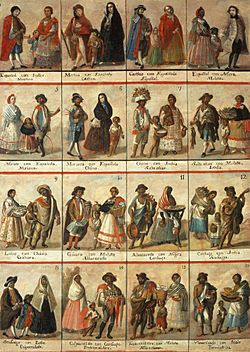
Since European colonization, the people of Latin America have a long history of mixing different backgrounds. Many Latin Americans with Native American or sub-Saharan African (and sometimes East Asian) ancestors also have European ancestors.
During the colonial period, a system called casta was used to classify people based on their racial background. Some main groups were:
- Indio: Native American people.
- Criollo: People of full European ancestry born in Latin America. Sometimes this included people who were mostly European with a small amount of Native American ancestry.
- Castizo: Someone who was three-quarters European and one-quarter Native American.
- Mestizo: Someone who was half European and half Native American.
- Negro: People of Sub-Saharan African descent.
- Mulato: Someone who was half European and half African.
- Zambo: Someone who was half African and half Native American.
- Pardo: People with European, African, and Native American ancestry.
- Peninsulares: Europeans born in Spain or Portugal.
In colonial times, people with any Jewish or Moorish (North African Muslim) ancestry were not allowed to join the Spanish Army or the Catholic Church. They had to get a "Limpieza de sangre" (purity of blood) certificate. This was a medieval idea that only applied to these religious groups. It did not apply to Native Americans in the colonies. People from all racial groups could join the army as long as they were Catholic. For example, Francisco Menendez, a freed Black military officer, served in the Spanish Army in the 18th century.
In Colonial Brazil and Imperial Brazil, there was discrimination against people of color. However, Brazil did not have a strict casta system like Hispanic America. White Brazilians, even those with some Native American or Black African ancestry, could have a high social status. This mixed ancestry is common among white Brazilians across all social classes. Having Moorish, Jewish, Arab, or Romani ancestry also affected social status less than in Hispanic America. However, this doesn't mean that people who were considered "fully non-white" had the same social status as the Brazilian elite.
Genetic Studies of European Ancestry
Scientists use DNA studies to understand the genetic makeup of populations. These studies show the average percentage of European ancestry in people from different countries in the Americas.
| Country | Proportion |
|---|---|
| Canada | 90% |
| Uruguay | 83% |
| USA | 79% |
| Cuba | 72% |
| Brazil | 71% |
| Argentina | 71% |
| Puerto Rico | 64% |
| Costa Rica | 61% |
| Nicaragua | 57% |
| Colombia | 57% |
| Venezuela | 56% |
| Chile | 52% |
| Honduras | 50% |
| Cayman Islands | 50% |
| Aruba | 50% |
| Dominican Republic | 47% |
| Ecuador | 42% |
| Mexico | 42% |
| Suriname | 40% |
| Guatemala | 40% |
| Bermuda | 37% |
| Belize | 38% |
| Bolivia | 21% |
| Bahamas | 16% |
| Netherlands Antilles | 15% |
| Curaçao | 15% |
| Barbados | 14% |
| Anguilla | 6% |
| Antigua and Barbuda | 4% |
Where White Latin Americans Live
The largest white population in Latin America is in Brazil. As of 2010, 91 million Brazilians identified as white, which is about 47.7% of the total population. The southern part of Brazil has the most white people, at 79% of the population there.
Argentina also has a large number of white people. In terms of percentage of the total population, Uruguay, Argentina, and Costa Rica have the highest numbers. White people make up 80–90% of their total populations. The smallest percentage is in Honduras, with only 1%.
| Country | Percentage of the local population | Population in (millions) |
|---|---|---|
| 88 | 3.4 | |
| 86 | 36.7 | |
| 82.7 | 3.2 | |
| 75.8 | 2.6 | |
| 64.1 | 7.16 | |
| 52 | 9.1 | |
| 47.7 | 91 | |
| 47 | 56 | |
| 43.6 | 13.1 | |
| 37 | 18.2 | |
| 18.5 | 2.7 | |
| 17 | 1 | |
| 16 | 2.0 | |
| 15 | 4.4 | |
| 12.0 | 0.6 | |
| 10 | 0.720 | |
| 6.1 | 0.330 | |
| 5 | 0.950 | |
| 5 (est.) | 0.524 (est.) | |
| 3.0 | 0.210 | |
| 1.0 | 0.089 |
A 2016 survey called Latinobarómetro asked people in Latin America to describe their race. Here are the results:
| Country | Mestizo | White | Indigenous | Mulatto | Black | Other race | Asian |
|---|---|---|---|---|---|---|---|
| Ecuador | 81 | 4 | 7 | 3 | 3 | 0 | 1 |
| Paraguay | 81 | 3 | 3 | 1 | 1 | 2 | 0 |
| Peru | 76 | 6 | 7 | 1 | 1 | 1 | 1 |
| El Salvador | 68 | 10 | 5 | 4 | 4 | 0 | 2 |
| Nicaragua | 67 | 6 | 8 | 2 | 3 | 0 | 1 |
| Honduras | 62 | 1 | 13 | 16 | 2 | 1 | 1 |
| Bolivia | 57 | 4 | 27 | 1 | 1 | 1 | 0 |
| Panama | 53 | 16 | 7 | 5 | 10 | 1 | 1 |
| Mexico | 52 | 6 | 19 | 2 | 0 | 3 | 1 |
| Colombia | 47 | 26 | 5 | 5 | 6 | 2 | 0 |
| Venezuela | 33 | 32 | 4 | 21 | 8 | 0 | 0 |
| Costa Rica | 31 | 40 | 4 | 17 | 3 | 1 | 1 |
| Dominican Republic | 29 | 11 | 4 | 24 | 26 | 0 | 3 |
| Argentina | 26 | 61 | 1 | 1 | 1 | 3 | 0 |
| Chile | 59 | 30 | 8 | 1 | 0 | 2 | 0 |
| Brazil | 27 | 41 | 1 | 13 | 17 | 1 | 0 |
| Guatemala | 32 | 17 | 45 | 1 | 1 | 1 | 0 |
| Uruguay | 7 | 74 | 1 | 4 | 3 | 3 | 0 |
| Latin America | 47 | 24 | 9 | 6 | 5 | 1 | 1 |
White Populations in North America
Mexico's White Population

Estimates for Mexico's white population vary widely, from 9% to almost 47%. The higher number comes from a recent government survey. This survey aimed to understand racism faced by Mexicans of Indigenous or African descent. Mexican society often favors lighter-skinned people who look European. Most white Mexicans have Spanish ancestors.
However, many non-Spanish or Portuguese immigrants also came to Mexico. These included French people in the 1860s. Later, in the late 1800s and early 1900s, people from Italy, Germany, Ireland, the United Kingdom, Lebanon, and Palestine made Mexico their home. In the 20th century, white Americans, Canadians, Greeks, Romanians, Portuguese, Armenians, Poles, Russians, and Jews also settled in Mexico. Many Spanish refugees fleeing the Spanish Civil War also came.
Mexico's northern and western regions have the highest percentages of European people. According to historian Howard F. Cline, most Mexicans in these areas have no Native American ancestry. They look similar to people from northern Spain. In these regions, Native American tribes were smaller and less organized. They often stayed separate from Mexican colonists or were even hostile towards them. The northeast region, where early European settlers removed the indigenous population, became the area with the most white people during the Spanish colonial period. However, recent immigrants from southern Mexico are changing these population trends.
In the last ten years, Mexico's economy has grown. This has led to more immigration, including Europeans seeking better work. People from the United States have also moved to Mexico. They now make up over three-quarters of Mexico’s roughly one million documented foreigners.
White Populations in the Caribbean
Cuba's White Population
White people make up 64.1% of Cuba's population, according to the 2012 census. Most have diverse Spanish ancestors. However, after many people left Cuba during the Cuban Revolution in 1959, the number of white Cubans living in Cuba decreased. Today, reports on the percentage of whites in Cuba are different. Some reports from Cuba still say around 65%, while others from outside Cuba say 40–45%.
Most white Cubans have Spanish ancestors. But many also have French, Portuguese, German, Italian, or Russian family roots. During the 18th, 19th, and early 20th centuries, many people from different regions of Spain, like the Canary Islands, Catalonia, Andalusia, Castile, and Galicia, moved to Cuba. Between 1901 and 1958, over a million Spaniards arrived. Many of them and their families left after Fidel Castro's Communist government took power. Another important group of immigrants came from various Middle Eastern countries. Many Jews also moved there, including Sephardi Jews.
A 2014 DNA study found that the genetic makeup in Cuba is about 72% European, 20% African, and 8% Native American.
Dominican Republic's White Population
In 1750, estimates showed that 30,863 white people lived in the colony of Santo Domingo. This was out of a total population of 70,625. The first national census was in 1920.
| European and white population 1750 - 1960 Census | ||||
|---|---|---|---|---|
| Year | Population | Percent | Total population | Reference |
| 1750 | 30,863 | 43.7% | 70,625 | |
| 1790 | 40,000 | 32.0% | 125,000 | |
| 1846 | 80,000 | 48.5% | ||
| 1920 | 223,144 | 24.9% | 894,665 | |
| 1935 | 192,732 | 13.0% | 1,479,417 | |
| 1950 | 600,994 | 28.14% | 2,135,872 | |
| 1960 | 489,580 | 16.1% | 3,047,070 | |
| 2006 Survey | 1.6 Million | 13.6% | ||
The CIA World Factbook states that white people are 16% of the Dominican Republic's population. Most of them have Spanish ancestors. Other notable ancestries include French, Italian, Lebanese, German, and Portuguese.
The government of Rafael Trujillo wanted to increase the white population. This was part of a plan to "whiten" the country's racial makeup. He did this by not allowing Black immigrants from Haiti and by welcoming Jewish refugees in 1938 and Spanish farmers in the 1950s. The country's German minority is the largest in the Caribbean.
Haiti's White Population
White and mulatto people make up about 5% of Haiti's population. The other 95% is Black. This 5% minority group includes people from many different backgrounds. They are French, Spanish, Middle Eastern, Portuguese, Russian, Dutch, Swiss, Armenian, Poles (Polish legion), Jews (from the Polish legion and during the Holocaust), Germans (18th century and World War I), and Italian.
Martinique's White Population
White people in Martinique make up 5% of the population. Since Martinique is a French overseas department, most white people there are French.
Puerto Rico's White Population
Early censuses were taken in Puerto Rico by the Spanish government. The 1899 Puerto Rico Census was done by the United States War Department. Since 1910, Puerto Rico has been part of every ten-year census taken by the United States.

| European or white population 1530 - 2010 Census | |||||||
|---|---|---|---|---|---|---|---|
| Year | Population | Percent | Ref(s) | Year | Population | Percent | Ref(s) |
| 1530 | 333a, 426b | 8-10.0 | ab | 1887 | 474,933 | 59.5 | |
| 1765 | 17,572 | 39.2 | 1897 | 573,187 | 64.3 | ||
| 1775 | 30,709 | 40.4 | 1899 | 589,426 | 61.8 | ||
| 1787 | 46,756 | 45.5 | 1910 | 732,555 | 65.5 | ||
| 1802 | 78,281 | 48.0 | 1920 | 948,709 | 73.0 | ||
| 1812 | 85,662 | 46.8 | 1930 | 1,146,719 | 74.3 | ||
| 1820 | 102,432 | 44.4 | 1940 | 1,430,744 | 76.5 | ||
| 1827 | 150,311 | 49.7 | 1950 | 1,762,411 | 79.7 | ||
| 1830 | 162,311 | 50.1 | 2000 | 3,064,862 | 80.5 | ||
| 1836 | 188,869 | 52.9 | 2010 | 2,825,100 | 75.8 | ||
| 1860 | 300,406 | 51.5 | |||||
| 1877 | 411,712 | 56.3 | |||||
White Puerto Ricans, mostly of Spanish descent, are said to be the majority. About 75.8% of the population identifies as white. In 1899, after the U.S. took control of the island, 61.8% identified as white. In 2000, the census asked people to define their race for the first time in fifty years. The percentage of whites had risen to 80.5% (3,064,862). This wasn't because more white people moved to the island. Instead, it was a change in how people thought about race. Puerto Rican leaders wanted to show Puerto Rico as the "white island of the Antilles."
From the early 1900s, American observers noted the "surprising number of white people" on the island. One writer called Puerto Rico "the whitest of the Antilles." A geologist wrote that the island was "special among the West Indian group because its main population is of the white race."
During the 19th century, hundreds of families from Corsica, France, the Middle East, and Portugal arrived in Puerto Rico. Many immigrants also came from Spain, especially from Catalonia, Asturias, Galicia, the Balearic Islands, Andalusia, and the Canary Islands. Many Spanish loyalists from Spain's former colonies in South America also settled there. Other settlers included Irish, Scots, Germans, and Italians. Thousands of immigrants received land from Spain through the Real Cedula de Gracias de 1815 (Royal Decree of Graces of 1815). This allowed European Catholics to settle on the island and receive free land.
A genetic study by the University of Brasilia found that Puerto Rican genetic makeup is about 60.3% European, 26.4% African, and 13.2% Native American.
Saint Barthélemy's White Population
Most people in Saint Barthélemy speak French. They are descendants of the first settlers from Normandy and Brittany.
White Populations in Central America
Costa Rica's White Population

From the late 1800s until the Panama Canal opened, European migrants used Costa Rica to cross Central America. They were trying to reach the west coast of the United States (California).
In Costa Rica, estimates for the percentage of white people range from 77% to 82%. This is about 3.1 to 3.5 million people. The CIA World Factbook says that white and mestizo populations together make up 83%. Most Costa Ricans with European ancestors are Spanish. However, many also have Italian, Greek, German, English, Dutch, French, Irish, Portuguese, Lebanese, or Polish family roots. Other groups include Russians, Danes, Belgians, Croats, Hungarians, Turks, Armenians, and Georgians.
Many of the first Spanish colonists in Costa Rica may have been Jewish people who converted to Christianity. They were expelled from Spain in 1492 and went to faraway colonies to avoid the Inquisition. The first large group of people who identified as Jewish came from Poland, starting in 1929. From the 1930s to the early 1950s, anti-Jewish campaigns in newspapers and by officials led to harassment. However, by the 1950s and 1960s, these immigrants became more accepted. Most of the 3,500 Costa Rican Jews today do not follow all religious rules strictly, but they often marry within their own group.
El Salvador's White Population
According to the official 2007 Census in El Salvador, 12.7% of Salvadorans identified as white. A genetic study by the University of Brasilia shows that Salvadoran genetic makeup is about 45.2% Native American, 45.2% European, and 9.7% African.
Guatemala's White Population
| Official census | |||||
|---|---|---|---|---|---|
| Year | White | Mayan | Mestizo | Others/immigrants | |
| 1898 | 8.0 | 74.7 | 15.1 | 2.2 | |
| 1940 | 29.0 | 53.2 | 15.1 | 2.7 | |
| 1980 | 13.0 | 46.5 | 38.9 | 1.6 | |
| 2002 | 16.4 | 42.5 | 39.4 | 1.7 | |
| 2010 | 18.5 | 38.2 | 41.3 | 2.0 | |
| Racial composition (percentages) by the official census of Guatemala. |
|||||
A national study from 2010-2012 estimated that white Guatemalans are 18.5% of the population (2.7 million people). Most of them are descendants of Germans, followed by those from Spain, France, Italy, England, Sweden, Belgium, Switzerland, Denmark, Norway, Netherlands, Russia, Scotland, Ireland, Wales, and other parts of Europe. There are also descendants of Americans, Canadians, and white people from other Latin American countries like Argentina and Costa Rica.
During the 19th and 20th centuries, Guatemala had a lot of immigration from Germany, Belgium, and Italy. There was also some immigration from Spain, France, Great Britain, Denmark, Switzerland, the Netherlands, Scandinavian countries, Ireland, and other European countries. From the mid-1800s to the early 1900s, immigration from Russia, Poland, and Greece was encouraged. Immigrants were given land for coffee farms and vineyards in areas like Cobán, Zacapa, Guatemala City, Quetzaltenango, Chiquimula, and El Progreso.
By 1940, the percentage of Guatemalans of European origin reached 29%. They became the majority in the capital and in the east. They also had significant populations in Verapaces, Quetzaltenango, and parts of the southwest. But by 1980, European immigration decreased, and the number of indigenous and mestizo families increased. So, the percentage of white people fell to 13%. Later, after a conflict that affected many non-white families, the percentage rose again. This also happened for people of mixed mestizo and European descent.
Nicaragua's White Population
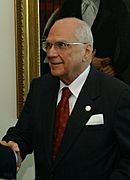
According to research from 2010 and 2014, European ancestry is most common in 69% of Nicaraguans. African ancestry is next at 20%, and Native American ancestry is 11%. This makes Nicaragua the country in Central America with the highest percentage of European ancestry. The CIA World Factbook states that in 2016, about 69% of Nicaragua's population was mestizo, 17% white, 5% Native American, and 9% black and other races. These numbers can change with migration. As of 2013, 58% of the population lived in cities. White Nicaraguans are mainly of Spanish, German, Italian, Portuguese, Belgian, and French ancestry.
In the 19th century, Nicaragua saw many immigrants, mostly from Europe. Families from Germany, Italy, Spain, France, and Belgium moved to Nicaragua. They used money from Europe to start businesses. They created many farms, like coffee and sugarcane plantations. They also started newspapers, hotels, and banks. There is also a small Middle Eastern community in Nicaragua, including Syrian, Armenian, Palestinian, Jewish, and Lebanese people. Their total population is about 30,000.
Panama's White Population
White Panamanians make up 10% of the population. Most of them have Spanish ancestors. Other ancestries include Dutch, English, French, German, Swiss, Danish, Irish, Greek, Italian, Lebanese, Portuguese, Polish, Russian, and Ukrainian. There is also a notable and important Jewish community.
Honduras's White Population
Honduras has one of the smallest percentages of white people in Latin America. Only about 1% (around 89,000 people) of the total population is classified as white.
White Populations in South America
Argentina's White Population
The ancestors of Argentines are mostly European. They also have some Native American and African contributions. A 2009 DNA study found that the Argentine population averages 78.5% European, 17.3% Native American, and 4.2% African. Another DNA study in 2012 found the genetic makeup to be 65% European, 31% Native American, and 4% African.
Argentina's National Institute of Statistics and Censuses (INDEC) does not count ethnic or racial groups. So, there is no official data on the percentage of white Argentines today. However, different sources estimate the white population of European descent to be between 85% and 86.4%. If non-European Caucasian groups like Jews, Lebanese, Armenians, and other Middle Easterners are included, these numbers go up to between 86.1% and 89.7%. This means there are an estimated 34-36 million white people in Argentina.
White Argentines live throughout the country. But they are most concentrated in the east-central region of Pampas, the southern region of Patagonia, and the west-central region of Cuyo. Their numbers are smaller in the north-eastern region of Litoral. They are much smaller in the north-western provinces of Salta, Jujuy, Tucumán, Catamarca, La Rioja, and Santiago del Estero. These areas were the most populated by Native American and Mestizo people before the large immigration wave from 1857-1940. Few European newcomers settled there. In recent decades, the percentage of white Argentines in parts of Greater Buenos Aires and the provinces of Salta and Jujuy has decreased. This is due to people moving from northern provinces and immigration from Bolivia, Peru, and Paraguay.
Most of the white population in Argentina are descendants of immigrants who arrived from Europe and the Middle East in the late 1800s and early 1900s. A smaller number are from Spanish people who came during the colonial period. From 1506 to 1650, between 10,500 and 13,125 Peninsulares (Europeans born in Spain) settled in the Río de la Plata region. Colonial censuses showed that the number of Spaniards and Criollos was high in cities but lower in rural areas. The 1778 census of Buenos Aires showed that out of 37,130 people, 25,451 (68.55%) were Spaniards and Criollos. In Cuyo in 1777, Spaniards and Criollos were 4,491 (51.24%) out of 8,765 people. In Córdoba, Spanish/Criollo people made up 39.36% (about 14,170) of 36,000 people.

In 1992, after the fall of Communist governments in the Soviet Union and its allies, Western European governments worried about many people leaving Central Europe and Russia. President Carlos Menem offered to welcome some of these immigrants to Argentina. A resolution in 1994 allowed "special treatment" for people wanting to move from the former Soviet Union. From January 1994 to December 2000, 9,399 Central and Eastern Europeans settled in Argentina. Of these, 6,720 were Ukrainians (71.5%), 1,598 Russians (17%), 526 Romanians, Bulgarians, Armenians, Georgians, Moldovans, and Poles. 555 (5.9%) traveled with a Soviet passport. Most newcomers (85%) were under 45, and 51% had a college education. They quickly became part of Argentine society, though some had to work for lower wages at first.
Bolivia's White Population
White people in Bolivia make up 5% of the nation's population. Most of them are criollos. These are families of pure Spanish ancestry who are descendants of the Spanish colonists and Spanish refugees from the 1936–1939 Spanish Civil War. These two groups have been a big part of the upper class since Bolivia became independent. Other white groups include Germans, who started the national airline Lloyd Aéreo Boliviano. There are also Italians, Americans, Basques, Lebanese, Croats, Russians, Polish, English, Irish, and other smaller groups. Many of these families have lived in Bolivia for several generations.
Brazil's White Population


Brazil is one of the few Latin American countries that includes racial categories in its censuses. These are Branco (White), Negro (Black), Pardo (Multiracial), Amarelo (Yellow), and Indígena (Native American). People choose their own category. Based on a 2010 survey, Brazil has the largest white population in Latin America. About 47.7% of Brazilians (91 million people) identified as "Brancos."
Comparing this to earlier censuses, the percentage of self-identified white Brazilians has slowly decreased. In 2000, it was 53.7%. In 2006, it was 49.9%. In 2008, it dropped to 48.4%. Some experts think this means more Brazilians are recognizing their mixed ancestry and identifying as "Pardos." Also, some experts estimate that 9% of self-declared white Brazilians have some African and Native American ancestry. If a strict rule were used, they might be classified as "Pardos."
White Brazilians live all over the country. But they are most concentrated in the four southernmost states, where 79.8% of the population identifies as white. The states with the highest percentage of white people are Santa Catarina (86.9%), Rio Grande do Sul (82.3%), Paraná (77.2%), and São Paulo (70.4%). Five other states have many white people: Rio de Janeiro (55.8%), Mato Grosso do Sul (51.7%), Espírito Santo (50.4%), Minas Gerais (47.2%), and Goiás (43.6%). São Paulo has the most white people in total, with 30 million.
In the 18th century, about 600,000 Portuguese people arrived in Brazil. This included wealthy immigrants and poor farmers. They were attracted by the Brazil Gold Rush in Minas Gerais. By the time Brazil became independent in 1822, an estimated 600,000 to 800,000 Europeans had come to Brazil. Most were male settlers from Portugal. Rich immigrants started the first sugarcane plantations in Pernambuco and Bahia. People fleeing religious persecution, like New Christians and Gypsies, were also among the early settlers.
After independence, Brazil tried to attract European immigrants. This was part of a policy called Branqueamento (Whitening). During the 19th century, European immigrants, especially Italians, gradually replaced enslaved workers. This happened mostly after 1850, when the slave trade in the Atlantic Ocean ended. It also happened as coffee farms grew in the São Paulo region. European immigration was highest between the mid-1800s and mid-1900s. Nearly five million Europeans moved to Brazil. Most were Italians (58.5%), Portuguese (20%), Germans, Spaniards, Poles, Lithuanians, and Ukrainians. Between 1877 and 1903, 1,927,992 immigrants entered Brazil, an average of 71,000 people per year. The peak year was 1891, when 215,239 Europeans arrived.
After World War I, the Portuguese became the main immigrant group again. Italians fell to third place. Spanish immigrants rose to second place because of poverty affecting many rural workers. Germans were fourth; they arrived especially during the Weimar Republic due to poverty and unemployment from World War I. The numbers of Europeans from other backgrounds increased. These included people from Poland, Russia, and Romania, who moved in the 1920s, likely due to political persecution. Other people came from the Middle East, especially from what are now Syria and Lebanon. Between 1821 and 1932, Brazil received an estimated 4,431,000 European immigrants.
After World War II, European immigration decreased a lot. However, between 1931 and 1963, 1.1 million immigrants entered Brazil, mostly Portuguese. By the mid-1970s, many Portuguese had moved to Brazil after Portugal's African colonies (Angola, Mozambique, and Guinea-Bissau) became independent. Some came from Macau because of the government there.
Chile's White Population

A 2015 DNA study found that Chileans are about 55.16% European, 42.38% Native American, and 2.44% African. Another DNA study from 2014 found the results to be 51.85% European, 44.34% Native American, and 3.81% African.
Studies estimate the white population in Chile to be between 20% and 52.7%. A genetic study by the University of Brasilia found that Chilean genetic makeup is 51.6% European, 42.1% Native American, and 6.3% African. A 2014 study of soldiers in Arica, Northern Chile, found that European ancestry ranged from 56.8% in soldiers born in Magallanes to 41.2% in those born in Tarapacá. A 2013 study found Chile's genetic makeup to be 52% European, 44% Native American, and 4% African.
A 2014 study showed that 37.9% of Chileans identified as white. DNA tests then showed that the average person who identified as white was genetically 54% European.
Physical traits in Chileans can vary by social class. For example, 13% of lower-class Chileans have at least one European surname (not Hispanic), compared to 72% of upper-middle-class Chileans. Only 9.6% of lower-class girls have light-colored eyes (green or blue), while 31.6% of upper-middle-class girls do. Blonde hair is present in 2.2% of lower-class girls and 21.3% of upper-middle-class girls. Black hair is more common among lower-class girls (24.5%) than upper-middle-class ones (9.0%).
Chile was not usually a popular place for migrants because it was far from Europe and hard to reach. However, in the 18th century, many immigrants from Spain came to Chile. Most were Basques, who quickly improved the economy and rose in society. They became part of the political leaders who still run the country today. An estimated 1.6 million (10%) to 3.2 million (20%) Chileans have a surname of Basque origin. The Basques liked Chile because it was similar to their homeland, with a cool climate, similar geography, fruits, seafood, and wine.
Spanish immigration was the most important European immigration to Chile. However, it was never as massive as in Argentina and Uruguay. So, the Chilean population was not "whitened" to the same extent. Still, immigrants have played a role in Chilean society. Between 1851 and 1924, Chile received only 0.5% of all European immigration to Latin America. Argentina received 46%, Brazil 33%, Cuba 14%, and Uruguay 4%. This was because migrants came across the Atlantic, not the Pacific. Before the Panama Canal was built, Europeans preferred to settle in countries closer to their homes. They did not want to take the long route through the Straits of Magellan or across the Andes mountains. In 1907, people born in Europe made up 2.4% of the Chilean population. This decreased to 1.8% in 1920 and 1.5% in 1930.
It is estimated that nearly 5% of the Chilean population has Asian descent, mainly from the Middle East. This includes Jews/Israelis, Palestinians, Syrians, and Lebanese, totaling about 800,000 people. Chile has a large population of immigrants, mostly Christian, from the Middle East. About 500,000 Palestinian descendants are believed to live in Chile.
About 5% of the Chilean population has some French ancestry. Over 700,000 (4.5%) Chileans may have British (English, Scottish, Irish, or Welsh) origins. Another important immigrant group is Croatian. The number of their descendants today is estimated to be 380,000, or 2.4% of the population. Some authors say that close to 4.6% of Chileans must have some Croatian ancestry.
After the failed liberal revolution of 1848 in the German states, many Germans immigrated. This started the German-Chilean community. The Chilean government encouraged these Germans (including German-speaking Swiss, Silesians, Alsatians, and Austrians) to settle in the southern region. They wanted to "civilize" and colonize the area. These immigrants mainly settled in Valdivia, Llanquihue, Chiloé, and Los Ángeles. The Chilean Embassy in Germany estimates that 150,000 to 200,000 Chileans are of German origin.
184,000 Chileans are descendants of Italians. Chileans of Greek descent are estimated to be 90,000 to 120,000. Most of them live in the Santiago or Antofagasta areas. Chile is one of the top 5 countries with the most Greek descendants. The descendants of the Swiss number 90,000. Other groups of European descendants are found in smaller numbers.
Colombia's White Population
The percentage of the Colombian population with mostly European ancestry is estimated at about 20%. However, in the 2005 Census, 37% of the total population identified as white. A genetic study by the University of Brasilia shows that Colombian genetic makeup is 45.9% European, 33.8% Native American, and 20.3% African.

Within 100 years after the first Spanish settlement, almost 95% of all Native Americans in Colombia had died. Most Native American deaths were caused by diseases like measles and smallpox, spread by European settlers. Many Native Americans were also killed in fights with European settlers.
White Colombians are mostly descendants of Spaniards. However, many Italian, German, Irish, Portuguese, and Lebanese Colombians are also found. Many Spanish colonists came looking for gold. Other Spaniards became leaders of social groups, teaching Native Americans the Christian faith and European ways. Catholic priests provided education for Native Americans that they could not get otherwise. There are many Colombian-German companies that work in finance, science, education, technology, and engineering.
Ecuador's White Population
According to the 2010 National Population Census, 6.1% of the population identified as white. This was down from 10.5% in 2001. In Ecuador, being white is more about social class than ethnic background. People often identify as white to show they are part of the middle class and to distance themselves from the lower class, which is linked to being "Indian." Because of this, people who are not mainly of European heritage might claim to be blanco. A genetic study by the University of Brasilia found that Ecuadorian genetic makeup is 64.6% Native American, 31.0% European, and 4.4% African.
White Ecuadorians, mostly criollos, are descendants of Spanish colonists. They also include Spanish refugees who fled the 1936–1939 Spanish Civil War. Most still own large amounts of land, mainly in the northern Sierra region. They live in Quito or Guayaquil. There are also many white people in Cuenca, a city in the southern Andes of Ecuador. This is because French people came to the area to measure the arc of the Earth. Cuenca, Loja, and the Galápagos attracted German immigrants in the early 1900s. The Galápagos also had a small Norwegian fishing community until they were asked to leave. There are notable populations of Italian, French, German, Basque, Portuguese, and Greek descent. There is also a small Ecuadorian Jewish population. Ecuador's Jews include Sephardi Jews who arrived in the south in the 16th and 17th centuries, and Ashkenazi Jews who came in the 1930s to the main cities of Quito and Cuenca.
French Guiana's White Population
12% of the population in French Guiana is white, and most of them are French.
Paraguay's White Population
Paraguay has one of the most similar populations in South America in terms of ethnicity, culture, and society. In 1814, José Gaspar Rodríguez de Francia made a rule that white Spaniards and Europeans could not marry each other. They could only marry Black, mulattoes, mestizos, or native Guaraní people. This was done to prevent white supremacy in Paraguay, as De Francia believed all people were equal. Because of this, within a generation, most of the population was of mixed racial origin.
The exact percentage of the white Paraguayan population is not known. This is because the Paraguayan census does not include racial or ethnic identification, except for the indigenous population. In the 2002 census, indigenous people were 1.7% of the total population. Other sources estimate the mestizo population at 95% by the CIA World Factbook. All other groups together make up 5%. So, white people and other groups (Asians, Afro-Paraguayans, others) make up about 3.3% of the total population. This is complicated because, like in other parts of Latin America, "white" and "mestizo" are not always separate categories. People might identify as both.
Because of European migration in the 19th and 20th centuries, most white people in Paraguay are of German descent (including Mennonites). Others are of French, Italian, Spanish, and Portuguese descent. Many are southern and southeastern Brazilians (brasiguayos), as well as Argentines and Uruguayans, and their descendants. People from these regions are generally descendants of colonial settlers and/or more recent immigrants.
In 2005, 600 families of Volga Germans who had moved to Germany after the fall of the Soviet Union re-migrated. They started a new colony called Neufeld near Yuty (Caazapá Department), in southeastern Paraguay.
Peru's White Population
White Peruvians make up 19.5% of the population, according to the latest census on Peru's ethnic makeup. The CIA World Factbook says they are 15% or 4.6 million people. They are mainly descendants of Spanish colonists and Spanish refugees from the Spanish Civil War. After World War II, many German refugees fled to Peru and settled in large cities. Others are descendants of Italian, French (mainly Basques), Austrian or German, Portuguese, British, Russians, Croats, Lebanese, Jordanian, and Syrian immigrant families. Most white people live in the largest cities. They are concentrated in the northern coastal cities of Trujillo, Chiclayo, Piura, and of course the capital Lima. Cajamarca and San Martín Region, and the highlands of northwestern Peru, also have strong Spanish and other European influences and ethnic presence. The only southern city with a significant white population is Arequipa.
A genetic study by the University of Brasilia found that Peruvian genetic makeup is 73.0% Native American, 15.1% European, and 11.9% African.
Uruguay's White Population
A 2009 DNA study in the American Journal of Human Biology showed that Uruguay's genetic makeup is mainly European. Native American ancestry ranges from 1% to 20%, and African ancestry from 7% to 15%, depending on the region.
Between the mid-1800s and early 1900s, Uruguay received some of the same immigrants as Argentina, though it started a bit earlier. From 1850-1900, the country welcomed four waves of European immigrants, mostly Spaniards, Italians, and French. Smaller numbers came from Britain, Germany, Switzerland, Russia, Portugal, Poland, Bulgaria, Hungary, Ukraine, Lithuania, Estonia, the Netherlands, Belgium, Croatia, Lebanon, Armenia, Greece, Scandinavia, and Ireland. These waves had a bigger impact on Uruguay's population than on Argentina's. Uruguay grew from 70,000 people in 1830 to 450,000 in 1875, and a million by 1900. Its population increased fourteen times in just 70 years. Between 1840 and 1890, 50%-60% of Montevideo's population was born abroad, almost all in Europe. The 1860 Census showed that 35% of the country's population was foreign-born. By the 1908 Census, this number dropped to 17%.
Recently, many European and American immigrants have moved to Uruguay. They are looking for peace and safety, or escaping pollution and high taxes in their home countries. In 1997, the Uruguayan government gave residence rights to only 200 European/American citizens. In 2008, the number of residence rights granted increased to 927.
Venezuela's White Population


According to the official Venezuelan census, "white" can mean external features like light skin, hair, and eye color. However, the term "white" has been used differently over time and in different places. So, its exact meaning can be confusing. For this reason, White Venezuelan describes a Venezuelan citizen of European origin.
The 2011 National Population and Housing Census reported that 43.6% of the population identified as white people. A genetic study shows that about 60.6% of the Venezuelan gene pool has European origin. Among the Latin American countries in the study (Argentina, Bahamas, Brazil, Chile, Costa Rica, Colombia, El Salvador, Ecuador, Jamaica, Mexico, Peru, Puerto Rico, and Venezuela), Brazil, Venezuela, and Argentina show the highest European contribution.
The Venezuelan gene pool is about 60.6% European, 23.0% Native American, and 16.3% African. Spaniards came to Venezuela during the colonial period. Most were from Andalusia, Galicia, Basque Country, and the Canary Islands. Until the last years of World War II, many European immigrants to Venezuela came from the Canary Islands. Their culture had a big impact on the Spanish language in the country, its food, and customs.
With the start of oil production in the early 1900s, employees of oil companies from the United States, United Kingdom, and the Netherlands settled in Venezuela. Later, in the mid-20th century, there was a new wave of immigrants. They came from Spain (mainly Galicia, Andalusia, and Basque Country, some being refugees from the Spanish Civil War), Italy (mainly southern Italy and the Veneto region), and Portugal (from Madeira). Immigrants also came from Germany, France, England, Croatia, the Netherlands, other European countries, and the Middle East (Lebanon). They were encouraged by a welcoming immigration policy in a rich, fast-developing country that needed educated and skilled immigrants.
Images for kids
-
Las castas. 18th century, Museo Nacional del Virreinato, Tepotzotlán, Mexico.
-
Mexican filmmaker Guillermo del Toro
-
Puig at the 2016 US Open.
-
Debi Nova, Costa Rican singer of Polish descent
-
Enrique Bolaños, 82nd President of Nicaragua, is of Spanish and German heritage.
-
Young people in Crespo, Entre Ríos. In this city, most Argentinians are descended from Volga Germans. The city's motto is "Crespo: melting pot, culture of faith and hard work", referring to the Volga Germans, Italians, Spaniards, and other ethnicities that comprise its population.
-
Kaká was named the FIFA World Player of the Year 2007.
-
Gisele Bündchen of Brazil, the highest-paid model in the world
-
Manuel Pellegrini, football manager.
-
Juanes, Colombian musician who has Basque ancestry.
-
Stefanía Fernández, Venezuelan pageant titleholder is of Ukrainian, Polish and Spanish ancestry
-
Édgar Ramírez, Venezuelan actor is of European ancestry




